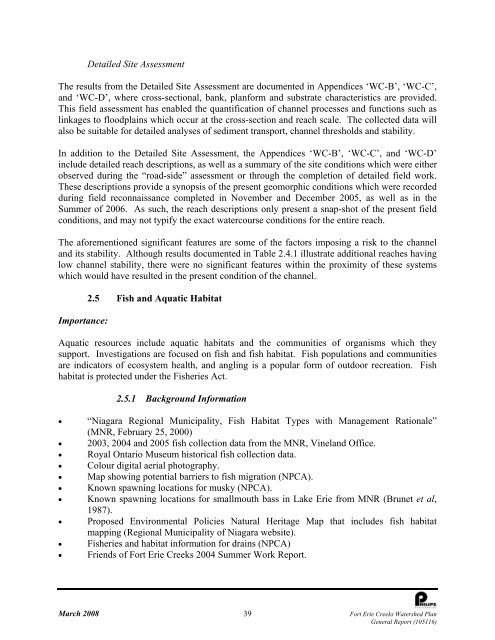Fort Erie Creeks Watershed Plan - Niagara Peninsula Conservation ...
Fort Erie Creeks Watershed Plan - Niagara Peninsula Conservation ...
Fort Erie Creeks Watershed Plan - Niagara Peninsula Conservation ...
You also want an ePaper? Increase the reach of your titles
YUMPU automatically turns print PDFs into web optimized ePapers that Google loves.
Detailed Site Assessment<br />
The results from the Detailed Site Assessment are documented in Appendices ‘WC-B’, ‘WC-C’,<br />
and ‘WC-D’, where cross-sectional, bank, planform and substrate characteristics are provided.<br />
This field assessment has enabled the quantification of channel processes and functions such as<br />
linkages to floodplains which occur at the cross-section and reach scale. The collected data will<br />
also be suitable for detailed analyses of sediment transport, channel thresholds and stability.<br />
In addition to the Detailed Site Assessment, the Appendices ‘WC-B’, ‘WC-C’, and ‘WC-D’<br />
include detailed reach descriptions, as well as a summary of the site conditions which were either<br />
observed during the “road-side” assessment or through the completion of detailed field work.<br />
These descriptions provide a synopsis of the present geomorphic conditions which were recorded<br />
during field reconnaissance completed in November and December 2005, as well as in the<br />
Summer of 2006. As such, the reach descriptions only present a snap-shot of the present field<br />
conditions, and may not typify the exact watercourse conditions for the entire reach.<br />
The aforementioned significant features are some of the factors imposing a risk to the channel<br />
and its stability. Although results documented in Table 2.4.1 illustrate additional reaches having<br />
low channel stability, there were no significant features within the proximity of these systems<br />
which would have resulted in the present condition of the channel.<br />
Importance:<br />
2.5 Fish and Aquatic Habitat<br />
Aquatic resources include aquatic habitats and the communities of organisms which they<br />
support. Investigations are focused on fish and fish habitat. Fish populations and communities<br />
are indicators of ecosystem health, and angling is a popular form of outdoor recreation. Fish<br />
habitat is protected under the Fisheries Act.<br />
2.5.1 Background Information<br />
• “<strong>Niagara</strong> Regional Municipality, Fish Habitat Types with Management Rationale”<br />
(MNR, February 25, 2000)<br />
• 2003, 2004 and 2005 fish collection data from the MNR, Vineland Office.<br />
• Royal Ontario Museum historical fish collection data.<br />
• Colour digital aerial photography.<br />
• Map showing potential barriers to fish migration (NPCA).<br />
• Known spawning locations for musky (NPCA).<br />
• Known spawning locations for smallmouth bass in Lake <strong>Erie</strong> from MNR (Brunet et al,<br />
1987).<br />
• Proposed Environmental Policies Natural Heritage Map that includes fish habitat<br />
mapping (Regional Municipality of <strong>Niagara</strong> website).<br />
• Fisheries and habitat information for drains (NPCA)<br />
• Friends of <strong>Fort</strong> <strong>Erie</strong> <strong>Creeks</strong> 2004 Summer Work Report.<br />
March 2008 39 <strong>Fort</strong> <strong>Erie</strong> <strong>Creeks</strong> <strong>Watershed</strong> <strong>Plan</strong><br />
General Report (105116)
















